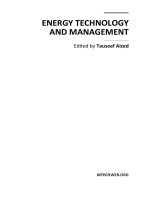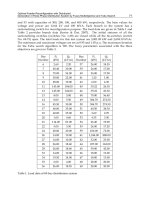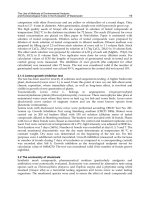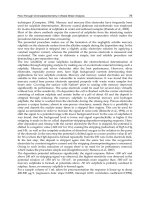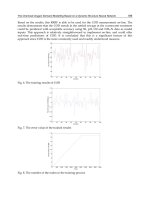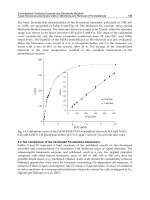Waste Water Evaluation and Management Part 1 docx
Bạn đang xem bản rút gọn của tài liệu. Xem và tải ngay bản đầy đủ của tài liệu tại đây (971.58 KB, 30 trang )
WASTE WATER ͳ
EVALUATION AND
MANAGEMENT
Edited by Fernando S. García Einschlag
Waste Water - Evaluation and Management
Edited by Fernando S. García Einschlag
Published by InTech
Janeza Trdine 9, 51000 Rijeka, Croatia
Copyright © 2011 InTech
All chapters are Open Access articles distributed under the Creative Commons
Non Commercial Share Alike Attribution 3.0 license, which permits to copy,
distribute, transmit, and adapt the work in any medium, so long as the original
work is properly cited. After this work has been published by InTech, authors
have the right to republish it, in whole or part, in any publication of which they
are the author, and to make other personal use of the work. Any republication,
referencing or personal use of the work must explicitly identify the original source.
Statements and opinions expressed in the chapters are these of the individual contributors
and not necessarily those of the editors or publisher. No responsibility is accepted
for the accuracy of information contained in the published articles. The publisher
assumes no responsibility for any damage or injury to persons or property arising out
of the use of any materials, instructions, methods or ideas contained in the book.
Publishing Process Manager Katarina Lovrecic
Technical Editor Teodora Smiljanic
Cover Designer Martina Sirotic
Image Copyright Natthawat Wongrat, 2010. Used under license from Shutterstock.com
First published March, 2011
Printed in India
A free online edition of this book is available at www.intechopen.com
Additional hard copies can be obtained from
Waste Water - Evaluation and Management, Edited by Fernando S. García Einschlag
p. cm.
ISBN 978-953-307-233-3
free online editions of InTech
Books and Journals can be found at
www.intechopen.com
Part 1
Chapter 1
Chapter 2
Chapter 3
Chapter 4
Chapter 5
Chapter 6
Preface IX
Waste Water Quality Monitoring 1
The Use of Methods of Environmental
Analysis and Ecotoxicological Tests
in the Evaluation of Wastewater 3
Helena Zlámalová Gargošová, Milada Vávrová,
Helena Doležalová Weissmannová, Ludmila
Mravcová, Lucie Vydrová and Libor Zouhar
Assessment of Micropollutants from Municipal
Wastewater- Combination of Exposure and
Ecotoxicological Effect Data for Switzerland 31
Kase Robert, Eggen Rik I L, Junghans Marion,
Götz Christian and Juliane Hollender
Water Toxicity Monitoring using
Optical Oxygen Sensing and Respirometry 55
Alice Zitova, Greg Jasionek and Dmitri B. Papkovsky
Flow-Through Chronopotentiometry
in Waste Water Analysis 71
Ernest Beinrohr
The Chemical Oxygen Demand Modelling Based
on a Dynamic Structure Neural Network 93
Junfei Qiao, Qili Chen and Honggui Han
Formaldehyde Oxidizing Enzymes and Genetically
Modified Yeast Hansenula polymorpha Cells
in Monitoring and Removal of Formaldehyde 115
Vladimir Sibirny, Olha Demkiv, Sasi Sigawi, Solomiya Paryzhak,
Halyna Klepach, Yaroslav Korpan, Oleh Smutok,
Marina Nisnevich, Galina Gayda, Yeshayahu Nitzan,
Czesław Puchalski and Mykhailo Gonchar
Contents
Contents
VI
Satellite Monitoring and Mathematical Modelling
of Deep Runoff Turbulent Jets in Coastal Water Areas 155
Valery G. Bondur
Intelligent Photonic Sensors for Application
in Decentralized Wastewater Systems 181
Michal Borecki, Michael L. Korwin-Pawlowski, Maria Beblowska,
Jan Szmidt, Maciej Szmidt, Mariusz Duk,
Kaja Urbańska and Andrzej Jakubowski
Analysis and Selective Treatment
of Radioactive Waste Waters and Sludges 203
György Pátzay, László Weiser, Ferenc Feil and Gábor Patek
Evaluation of Waste Water Effects on the Environment 217
Effects of Waste Water on Freshwaters
in Semiarid Regions 219
Miguel Alvarez-Cobelas, Salvador Sánchez-Carrillo,
Angel Rubio-Olmo and Santos Cirujano-Bracamonte
Hydrochemical Investigation of Groundwater Contamination
in the Grombalia Shallow Aquifer, Cap Bon Peninsula, Tunisia:
Impact of Irrigation with Industrial Waste Water 239
Amor Ben Moussa and Kamel Zouari
Effects of Wastewater Treatment Plant on Water Column and
Sediment Quality in Izmir Bay (Eastearn Aegean Sea) 253
F. Sanem Sunlu, Ugur Sunlu, Baha Buyukisik,
Serkan Kukrer and Mehmet Aksu
Effects of Domestic Waste Water on Water Quality
of Three Reservoirs Supplying Drinking Water
in Kaduna State - Northern Nigeria 269
Yahuza Tanimu, Sunday Paul Bako and John Ameh Adakole
Water Quality of Streams Receiving Municipal Waste
Water in Port Harcourt, Niger Delta, Nigeria 283
Alex C. Chindah, Solomon A. Braide, and Charles C. Obunwo
Impact of Municipal Waste Water on Growth
and Nutrition of Afforested Pinus eldarica Stands 303
Masoud Tabari, Azadeh Salehi and Jhangard Mohammadir
Parasitological Contamination in Organic
Composts Produced with Sewage Sludge 313
Eduardo Robson Duarte, Flávia Oliveira Abrão,
Neide Judith Faria de Oliveira and Bruna Lima Cabral
Chapter 7
Chapter 8
Chapter 9
Part 2
Chapter 10
Chapter 11
Chapter 12
Chapter 13
Chapter 14
Chapter 15
Chapter 16
Contents
VII
Effects of Reclaimed Water
on Citrus Growth and Productivity 325
Kelly T. Morgan
Heavy Metal Contamination of Zn, Cu, Ni and Pb
in Soil and Leaf of Robinia pseudoacacia Irrigated
with Municipal Wastewater in Iran 341
Masoud Tabari, Azadeh Salehi,
Jahangard Mohammadi and Alireza Aliarab
Wastewater from Table Olive Industries 351
G.M. Cappelletti, G.M. Nicoletti and C. Russo
Waste Water Management and Environmental Policies 377
Wastewater Management 379
Peace Amoatey (Mrs) and Richard Bani
Sewage Sludge Disposal and Applications:
Self-heating and Spontaneous Combustion
of Compost Piles - Trace Metals Leaching
in Volcanic Soils After Sewage Sludge Disposal 399
Mauricio Escudey, Nelson Moraga,
Carlos Zambra and Mónica Antilén
Waste Water: Treatment Options
and its Associated Benefits 431
Akuzuo Ofoefule, Eunice Uzodinma and Cynthia Ibeto
Agricultural Dairy Wastewaters 447
Owen Fenton, Mark G. Healy, Raymond B. Brennan, Ana Joao
Serrenho, Stan T.J. Lalor, Daire O hUallacháin and Karl G. Richards
Chapter 17
Chapter 18
Chapter 19
Part 3
Chapter 20
Chapter 21
Chapter 22
Chapter 23
Pref ac e
Wastes are materials generated as a result of numerous anthropic activities and should
be disposed to prevent environmental pollution which aff ects human health and con-
tributes ecosystem degradation. Most of the environmental problems, which we are
dealing with, are a result of improper management of wastes. In particular, fresh water
resources are under serious stress throughout the globe. Water supply and water qual-
ity degradation are global concerns.
Anthropogenic pollution of natural waters constitutes of many substances and many
water bodies receive a varied range of waste water from point and/or non point sourc-
es. Hence there is an increasing need for be er tools to asses the eff ects of pollution
sources and prevent the contamination of aquatic ecosystems. The reduction of risks
to the aquatic systems requires the characterization of waste waters, the analysis of
the impact of waste water on freshwaters and the reduction of contaminants through
the application of appropriate policies and measures. Therefore, the development of
improved monitoring tools, impact evaluation approaches and treatment technologies
are active research fi elds.
The major sources of wastewater can be classifi ed as municipal, industrial and agricul-
tural. In order to evaluate the impact of these types of waste waters on the aquatic eco-
system, monitoring is necessary because wastewater is discharged back into surface.
To ensure the effl uent water quality, some global parameters such as biological oxygen
demand (BOD), chemical oxygen demand (COD), total organic carbon (TOC) and total
suspended solids (TSS) are usually measured. In addition to the la er indicators, toxi-
cological assessment of environmental samples is necessary for a proper monitoring of
wastewater quality. On the other hand, the use of models for predicting effl uent indica-
tors can provide eff ective guidance for the operation of waste water treatment plants.
This multi-authored book takes a look at various aspects concerning the evaluation
and management of waste water. The book chapters, heterogeneous in nature, were
invited by the publisher and the authors are responsible for their statements. The ac-
curacy of each chapter was checked by the authors through proof reading stages. The
book covers a wide spectrum of issues related to waste water monitoring, the evalua-
tion of waste water eff ect on diff erent natural environments and the management of
water resources. The reader will fi nd current information and data obtained in studies
undertaken to assess the quality of waste waters and the impact of pollution sources on
natural water bodies. The chapters are basically organized in three sections. In the fi rst
section, chapters are mainly focused on methods for monitoring parameters of waste
X
Preface
water quality. The second section includes several case studies dealing with the evalu-
ation of the eff ects of waste water on diff erent regions in the world. The fi nal section
covers topics related to waste water management and environmental policies.
We hope that this publication will be a useful document for students, professionals and
researchers of various disciplines related to waste water evaluation and management.
The book is a result of eff orts by many experts from diff erent fi elds. I would like to ac-
knowledge the authors, who are from diff erent countries, for their contribution to the
book. I wish to off er special thanks to Prof. Katarina Lovrecic for her exceptional help
throughout the preparation process.
Fernando García Einschlag
La Plata University
Argentina
Part 1
Waste Water Quality Monitoring
1
The Use of Methods of Environmental
Analysis and Ecotoxicological Tests
in the Evaluation of Wastewater
Helena Zlámalová Gargošová, Milada Vávrová, Helena Doležalová
Weissmannová, Ludmila Mravcová, Lucie Vydrová and Libor Zouhar
Brno University of Technology, Faculty of Chemistry
Czech Republic
1. Introduction
The term “new” environmental pollutant covers all anthropogenic contaminants that have
been released in the environment over the last few decades. Research into their fate and
impact on the environment has started relatively recently. The group of new environmental
pollutants consists of persistent organic pollutants (POPs) including DDT, polychlorinated
biphenyls, polycyclic aromatic hydrocarbons and a wide range of organic pesticides. This
group has recently been expanded with polybrominated flame retardants, drugs, detergents,
and personal hygiene products. Chemicals, used everyday in homes, industry and
agriculture, can enter the environment in wastewater. According to the United Nations
Organization 884 million people do not have access to safe drinking water, and over 2.6
billion people do not have access to proper sanitation systems. On July 28, 2010, the UN
General Assembly passed a resolution supporting water as a human right and urging
governments and international organizations to address this important human right.
Interest in the presence of pharmaceuticals, personal care products, and endocrine
disruptors in the environment has increased significantly over the last decade.
Pharmaceuticals and synthetic musk compounds in personal care products (PPCPs), are
groups of organic micropollutants which are routinely detected in surface water, ground
water and even in drinking water (McClellan and Halde, 2010). Hundreds of tons of these
compounds are dispensed in communities every year. PPCPs are regarded as being
potentially hazardous compounds as some are ubiquitous, persistent and biologically active
compounds with recognised endocrine disruption functions (Kasprzyk-Hordern et. al.,
2002). Many pharmaceuticals, upon administration, are degraded in the body and may even
become inactive, but others, often those applied externally, excreted or not absorbed fully,
can leave the body in their active forms. (Roberts &Thomas, 2006). The others only slightly
transformed or even unchanged often conjugated to endogenous substrate (e.g. glucuronic
acid, sulfuric acid, acetic acid to polar molecules. (Roberts and Thomas, 2006). These
conjugates are easily cleaved during sewage treatment and, thus, several pharmaceutically
active compounds (PhACs) are discharged almost unchanged from municipal sewage
treatment plants (STPs) into the receiving waters (Heberer, 2002). The wide range of trace
chemical contaminants persisting in municipal wastewater after conventional treatment
Waste Water - Evaluation and Management
4
includes inorganic compounds, heavy metals, persistent organic pollutants like endocrine
disrupting compounds, pharmaceutically active compounds; personal care products
(PPCPs), disinfection by-products and many other complex compounds persist through the
waste water treatment process. As a result, terrestrial and aquatic organisms can be exposed
to these compounds when treatment by-products are subsequently reintroduced into the
broader environment. Exposure can be associated with effluents from waste water treatment
plants (WWTPs) leach from landfills, and runoff or leach from land that has received
applications of reclaimed waters and/or biosolids. Thus, a number of PPCPs are widely
detected in water resources throughout the world (Edwards et al., 2009; Lapen et al., 2008;
Fatta-Kassinos et al., 2010). From reasons mentioned above is very important to monitor
large spectra of chemicals not only in biosolids, which represents inevitable by-products of
WWTPs, but in reclaimed water from municipal wastewater treatment. Waste water
treatments produces large amount of sewage sludges/biosolids. Part of them is after
treatment process used as fertilizer (Jones-Lepp & Stevens, 2006). The Sewage Sludge
Directive 86/278/EEC seeks to encourage the use of sewage sludge in agriculture and to
regulate its use in such a way as to prevent harmful effects on soil, vegetation, animals and
man. On the other hand sludge could be posing a risk for environment they tends to
concentrate heavy metals and organic but its, however, rich in nutrients such as nitrogen
and phosphorous and contains valuable organic matter. Directive 86/278/EEC sets limit
values for seven heavy metals, for some congeners of PCBs and AOX (Absorbable organic
halides) other organic compounds and ecotoxicity tests arenť required The European
Commission is currently assessing whether the current Directive should be reviewed – and
if so, the extent of this review (Council directive, 1986).
In the 1980´ and 90´the focus on the analysis of sewage sludge meanly deal with pathogens,
inorganic (metals), polynuclear aromatic hydrocarbons (PAHs), polychlorinated biphenyls
(PCBs) and polychlorinated dibenzo-p-dioxins and dibenzofurans (PCDD/Fs) (Alcock et al.;
1996 Eljarrat et al., 2001). In 21TH century analysis of these matrices is not target only for
selected traditional analytes but new xenobiotics as pharmaceuticals and musk compounds
in sewage sludge are reported (Herren & Berset 2000; Zorita et al., 2009; McClellan & Halde,
2010). Ecotoxicological evaluation of sewage sludge as integral part of environmental
analysis started to appear in this century sparsely (Park et al. 2005, Domene et al., 2008).
Chemicals analysis is integral part of water quality evaluation but to predict effect of this
water or used sewage sludge on environment is necessary to use some other possibilities.
Useful toll for this could be biotests. Global evaluation of wastewaters should include
ecotoxicological tests to complete the chemical characterization. The integrated assessment
of biological effects of wastewater discharges in the ecosystems is relevant and ecotoxicity
tests are referred as extremely useful tools for the identification of environmental impacts
(Mendonca et al., 2009).
1.1 Pharmaceuticals
Pharmaceuticals are biologically active substances. It is documented that drug production
and consumption are increasing worldwide, both in human and veterinary medicine. The
consequence of this trend is the increased input of these substances into the environment,
where they can exist in their original or metabolized form and can have significant impacts on
natural ecosystems (Halling-Sörensen, 1998). The hazardous source of pharmaceuticals
represents agriculture, predominantly livestock production. Growth stimulants and
antibiotics used as prophylaxis drugs entered ecosystem in faeces and urine as fertiliser
The Use of Methods of Environmental Analysis
and Ecotoxicological Tests in the Evaluation of Wastewater
5
without possibilities degradation on less active metabolites in WWTP (Koschorreck et al.,
2002). Biodegradation in digestive system of animals it is possible, but not for all substance.
In study (Halling-Sorensen et al., 1998; Hirsch et al., 1999) was demonstrate, that 30−90 %
doses of antibiotics enter he environment in origin form. At the end Pharmaceuticals are
specially target on elimination of pathogenic organisms, in this case they could decrease
number of microorganisms in WWTP and affect treatment process of water treatment.
Antibiotics were recently classified as a priority risk group due to their high toxicity to algae
and bacteria at low concentrations and their potential to cause resistance amongst natural
bacterial populations Hence, antibiotics in surface water have the potential to disrupt key
bacterial cycles/processes critical to aquatic ecology (nitrification/denitrification) or
agriculture (soil fertility) and animal production (rudimentary processes) (Watkinson et al.,
2007; Watkinson et al. , 2009).
Diclofenac
Sodium
Ibuprophen
sodium
Ampicillin Penicillin G
CAS 15307-79-6 31121-93-4 69-53-4 61-33-6
Physical state
White or slightly
yellowish
crystalline
powder, slightly
hygroscopic
Sparingly soluble
in water, freely
soluble in
methanol.
White crystalline
powder.
Sparingly
soluble in water,
freely soluble in
acetone,
methanol, ether.
White powder,
slightly
hygroscopic.
Soluble in
water, insoluble
in alcohol, oils.
White powder.
Soluble in water,
insoluble in
alcohol, various
oils and
paraffin’s.
Molecular
weight
(g/mol)
318.13 228.26 371.39 334.39
Melting point
(°C)
278-279 75−78 324.85 243.10
Boiling point
(°C) at 25°C
412.00 157.00 622.61 565.30
Water
solubility
(mg l
-1
) at 25°C
50.00 57,90 439.30 210.40
Henry’s Law
Constant
(atm.m
3
.mol
-1
)
5.29.10
-9
1.23.10
-6
2.97.10
-16
1.88.10
-13
Log K
OW
1.56
∼ 1.00
1.45 1.83
Log K
OC
2.92 2.59 2.73 2.63
Table 1. Physico-chemical characteristics of pharmaceuticals
Waste Water - Evaluation and Management
6
CH
3
CH
3
CH
3
O
OH
Diclofenac Ibuprofen
NH
N
S
CH
3
CH
3
O
OH
O
O
NH
N
S
CH
3
CH
3
NH
2
O
OH
O
O
H
Penicilin G Ampicillin
Fig. 1. Structural formulae of selected pharmaceuticals
Since pharmaceuticals are designed with the intention of performing a biological effect, this
concept may be very important for these specific substances in terms of fate and effects
toward non target organisms in the environment, even at low concentrations. The food
chain of some organisms is affected and pathogenic organisms can develop their resistance
against these substances. Another important problem is presented by the negative impact on
bacterial microflora in biological cleaning processes. Pharmaceuticals are classified as the so-
called "microcontaminants", which have been causing significant concern within the
environmental area during past years. (Beausse 2004; Gómez et al. ,2006)
The most pharmaceuticlas are not completely removed in the wastewater treatment plant
(Beausse, 2004; Gómez et al., 2006; Ramirez et al., 2007). They are partially eliminated by
sorption to wastewater sludge or by biodegradadion. The elimination level differs in
dependence on the substance type and process conditions. The elimination of antibiotics
from the wastewater treatment plants can be also affected by sludge age. Non-steroidal anti-
inflammatory drugs (NSAIDs) with analgesic, antipyretic and anti-inflammatory effects
such as diclofenac, ibuprophen and ketoprofen are one of the most widely used. It also
belongs to the most frequently detected pharmaceuticals in the water-cycle in Europe.
Antibiotics are the important group of the drugs affecting the environment. They are
classified as biological, semisynthetic or synthetic substances. They are characterized by
their selective toxicity against bacteria and they can be used to treat various infections. More
than one hundred antibiotics are presently used. The primary classification of antibiotics is
based on their effects and differentiates them on bactericidal and bacteriostatic. (Yang &
Carlson, 2003; Kay et al., 2005).
1.2 Musk compounds
Synthetic aromatic substances or musk compounds (“white musk”) are lipophilic
contaminants, with the ability to accumulate in the components of the environment. They
The Use of Methods of Environmental Analysis
and Ecotoxicological Tests in the Evaluation of Wastewater
7
belong to the group of priority persistent pollutants and may occur in the components of the
environment and human tissue. Since they have potential carcinogenic properties, efforts
are currently being made to limit or ban their use in many regions worldwide.
Generally, synthetic aromatic substances or musk compounds can be divided into 4 groups:
linear musk compounds, macrocyclic musk compounds, polycyclic musk compounds and
nitro musk compounds. The last two groups are used most frequently as fragrances in
personal hygiene products (perfumes, cosmetics, soaps, and shampoo), cleaning and
disinfection products, industrial cleaning products, air fresheners, etc.
Synthetic aromatic substances were launched on the market in the early 20th century. The
volume of their production has significantly increased over the last 50 years (Luckenbach &
Epel, 2005). Galaxolide (HHCB) and Tonalide (AHTN) are examples of the most important
musk compounds from the group of polycyclic compounds. Musk xylene, musk ketone and
musk ambrette are well-known nitro musk compounds. The production of nitro musk
compounds (i.e. compounds containing one or more nitro groups in a molecule) that are
generally included in a group of substances posing a risk to the environment has decreased
over the last years. By contrast, the production of polycyclic synthetic aromatic substances
that are less toxic has increased and these substances are used in an abundant manner as
additives in many products such as soaps, shampoos, deodorants, body lotions, perfumes,
cleaning and disinfecting agents, air fresheners, industrial cleaning agents, etc. Unlike nitro
Tonalide
(AHTN,
Fixolide)
Galaxolide
(HHCB,
Abbalide)
Musk ketone Musk xylene
CAS 1506-02-1 1222-05-5 81-14-1 81-15-2
Physical state
Soluble in
alcohol, oils,
white solid
crystal
Viscous liquid,
No colour and
stabile liquid
Soluble in
alcohol,
various oils,
pale yellow
crystals
Soluble in
alcohol, oils,
pale yellow
crystals or fine
crystalline
powder
Molecular
weight
(g/mol)
258.41 258.39 294.27 297.27
Melting point
(°C)
104.26 104.26 241.07 245.65
Boiling point
(°C) at 25°C
325.92 325.92 560.94 570.75
Water
solubility (mg
l
-1
) at 25°C
0.24 0.21 0.46 0.15
Henry’s Law
Constant
(atm.m
3
.mol
-
1
)
2.28.10
-4
2.57.10
-4
1.33.10
-19
3.15.10
-17
Log K
OW
5.70 5.90 4.30 4.90
Log K
OC
3.72 3.72 3.58 3.58
Table 2. Physico-chemical characteristics of musk compounds
Waste Water - Evaluation and Management
8
Musk ketone Musk xylene
Tonalide Galaxolide
Fig. 2. Structural formulae of selected musk compounds
musk compounds, polycyclic musk compounds are more resistant against light and bases,
and bind to fabrics quite easily. They are therefore used in cosmetic products and detergents
more frequently. Logically, the reduced production of nitro musk compounds resulted in
the increased production of polycyclic substances.
Synthetic aromatic substances are lipophilic, persistent organic compounds that show
bioaccumulation abilities in the aquatic ecosystem. They were detected in the samples of air
and dust collected in self-contained premises (Regueiro et al., 2009). A number of studies
revealed the presence of musk compounds in the tissues of aquatic animals and also in
human tissues. Musk compounds were also detected in fat tissue, human milk and blood
plasma (Lignell et al., 2008).
The recent studies provided the presence of musk compounds in abiotic and biotic matrices.
After their application the AHTN and HHCB are generally transported to wastewater
treatment plants via industrial and municipal wastewaters (Fromme et al. 2001; Valdersnes et
al. 2006, Wombacher et al. 2009). The various concentrations of the polycyclic musks have been
determined in sewage treatment plants (on influent and effluent), surface waters, sediment in
varies region of Europe and their concentration in aquatic ecosystems is highly depended on
the distance from wastewater treatment plants. These toxic compounds are now widely found
in variety of biota in the many regions in the world and its typical organism (Tanabe 2005;
Nakata et al. 2007). The potential impact of polycyclic musk compounds were studied in
relation to biodegradation, bioconcentration, determination of their concentrations in
environmental matrixes (Bester 2009; Onesios et al. 2009; Lee et al. 2010; Sumner et al. 2010).
The Use of Methods of Environmental Analysis
and Ecotoxicological Tests in the Evaluation of Wastewater
9
2. Environmental analysis
The analysis of organic pollutants and the preparation of other samples required for the
analysis start with the concentration of an analytes which can be achieved by using different
methods, for example by liquid-liquid extraction, solid phase extraction, purge & trap,
headspace or other techniques that may be time demanding and require sophisticated
instruments and organic solvents.
The solid-phase microextraction method (SPME) is a simple and efficient sorption-
desorption technique allowing the analytes to be concentrated. It is based on the exposure of
a small amount of sorbent (extraction phase) to an excess of a sample. The goal of most
SPME procedures used for sample preparation prior to analysis is to obtain a particular
analytes in a sufficient detectable amount without any unwanted admixtures. In the case of
SPME, analytes bind to a fibre until the steady state is reached. The SPME method is used in
both qualitative and quantitative analysis. The accuracy and precision of the results is
affected by a number of factors. The SPME method provides linear calibration dependence
in a wide range of concentrations. The proper choice of fibre will ensure reproducible results
even at low levels of analytes.
SPE is typically performed manually, but there are some significant disadvantages with this
approach (Fatta et al., 2007):
- manual (off-line) SPE is time-consuming as well as labor-intensive and costly, which
compromises productivity;
- exposure to hazardous or infectious matrices (such as sewage) involves safety issues;
and,
- the recovery of the analytes can vary from batch to batch, causing reproducibility
problems.
- direct injection of untreated samples;
- automatic sample clean-up and/or analyte enrichment;
- elimination of conventional manual sample pretreatment
- steps;
- faster procedures;
- methods are less prone to errors, resulting in Berger reproducibility;
- reduction of health risks; and,
- samples can be run unattended (e.g., overnight or over the weekend).
The methods of high performance liquid chromatography (HPLC) with diode-array
detection (DAD) or mass detector (MS) are also the widely utilizing analytical method
(HPLC-DAD, HPLC-MS) for determination of pharmaceuticals and musk compounds. The
method gas chromatography with mass detector (GC-MS) or gas chromatography with
atomic emission detector (GC-AED) detect compound with excellent sensitivity.
2.1 Sampling area
The first one is large-scale wastewater treatment plant of the City of Brno (catchment region
for a population of 500,000 people). There is municipal waste water treated. This facility was
launched in 1961 as classic two-stage plant with anaerobic sludge stabilization. In the period
between 2001 – 2003 the overall reconstruction and extension of the WWTP was realized
with the main objective to meet the treated wastewater effluent limits set by Czech and
European standards and regulations, and to ensure sufficient capacity of the facility to
accommodate the growing demand of the city of Brno with almost 500 thousand of
Waste Water - Evaluation and Management
10
inhabitants and several industrial facilities, but also of increasing number of the
surrounding agglomerations successively connecting to the Brno sewerage system.
Nowadays, the technology in WWTP Brno-Modřice corresponds to the EU parameters. The
second WWTP collects waste water from laboratories and from research workplaces is there
collected. The municipal WWTP uses technology of anaerobic stabilization of sewage
sludges. This closing step is included to minimalize decomposition of residual organic
material and mainly to eliminate pathogenic organisms. Three previous steps of water
treatment include mechanical removing of settled elements, chemical treatment -
defosfatation and denitrification in anaerobic tank. Follow biological treatment in activated
tank, under oxygen conditions. Secondary settlement tank is final tank where is activated
sewage sludge settled and separated out from treated water. The technology of small local
WWTP located on the grounds of the University of Veterinary and Pharmaceutical Sciences
in Brno involves aeration in activated tank, followed with separation of activated sewage
sludges. Water is sanitized with chlorine and sewage sludges are thermic stabilised (125
°C/35min). Then water enters to communal sewerage system. The amber glass sample
bottles were used for this collection. The samples were processed immediately or stored in a
refrigerator till the following day. If necessary, the samples were filtered to remove rough
impurities.
WWTP Brno-Modřice
WWTP at Veterinary and Pharmaceutical
University Brno
Fig. 3. The sampling localities
Wastewater samples have been collected from the two wastewater treatment plant -
municipal WWTP Brno-Modřice and WWTP at Veterinary and Pharmaceutical University
Brno in one-day intervals and from in seven-days intervals. The sampling of waste water
and sludge for experiments were from the WWTP inlet, outlet and lagoon (pond) from
reason of comparing.
2.2 The analysis of pharmaceuticals
The application of advanced measurement technologies (e.g., gas chromatography with
mass spectrometry (GC-MS) and GC with tandem MS (GC-MS2) or liquid chromatography
with MS (LC-MS) and LC with tandem MS (LC-MS2)) to environmental analysis has
allowed the determination of a broader range of compounds, including pharmaceuticals,
and has therefore permitted more comprehensive assessment of environmental
contaminants. LC-MS2 is becoming more commonly used in pharmaceuticals analysis
The Use of Methods of Environmental Analysis
and Ecotoxicological Tests in the Evaluation of Wastewater
11
because of its high sensitivity and its ability to confirm compounds (as compared with
conventional LC with ultraviolet (UV) or fluorimetric detection). LC-MS2 allows separation
and detection of compounds having the same molecular mass but different product ions,
even if they co-elute. MS2 detection is therefore preferred for increased analytical sensitivity
and selectivity in complex matrices, such as wastewaters. (Kot-Wasik et al., 2007).
Fig. 4. Analytical methods applied for the most common pharmaceuticals in water and
wastewater (Fatta et al.,2007)
Waste Water - Evaluation and Management
12
Solid phase extraction (SPE) was employed as the separation method for isolation of given
pharmaceuticals and high performance liquid chromatography (HPLC) with diode-array
detection was used for their determination. The optimised and validation method was used
to model samples of water. Obtained results were evaluated and their interpretation was
done.
Several different columns were tested for diclofenac (Nonsteroidal anti-inflammatory
substances – NSAIDs). Oasis HLB is column with hydrophilic-lipophilic balance. It includes
copolymer divinylbenzen/N-vinylpyrrolidin. Often they are used for solid phase extraction
of pharmaceuticals.
Sorbent with polymerization bonded oktadecyl phase is in ENVI-18. These columns are
employed especially for environment. LC SAX was last tried column. It is ion exchanger
column with polymerization bonded quaternary amine.
From the Table 3 it is implied, that the respective procedure for SPE is acceptable for
diclofenac when using Oasis HLB and ENVI-18 cartridges. The Oasis HLB column was
selected as the suitable one, due to highest yields of diclofenac from the cartridges tested. To
find the optimal procedure SPE for both drugs, other SPE courses were tested on Oasis HLB
columns.
SPE
Original diclofenac
concentration
(mg/ml)
Final concentration of
diclofenac
(mg/ml)
Diclofenac
recovery
%
Oasis HLB 0.0150 0.0042 28.04
ENVI-18 0.0150 0.0036 24.23
LC-SAX 0.0150 2.37.10
-5
0.16
Table 3. Recovery on SPE columns HLB when testing various procedures
The pharmaceutical Diclofenac and Ibuprofene were determined at inflow and outflow of
WWTP Brno-Modřice. The determined concentration of ibuprophene at inflow was 1018.14
ng/l and at outflow 195.97 ng/l. The efficiency of water treatment process for Ibuprofene
was 80%. The aim of this work was to develop both a suitable analytic method for analytes
isolation from a given matrix and an optimal technique for identification and determination
of analgetics residues in waters. Solid phase extraction (SPE) was employed as the
separation method for isolation of given pharmaceuticals and high performance liquid
chromatography (HPLC) with diode-array detection was used for their determination. The
optimized method was used to model samples of water. Obtained results were evaluated
and their interpretation was done
The aim of this work was to develop both a suitable analytic method for analytes isolation
from a given matrix and an optimal technique for identification and determination of
analgetics residues in waters. Solid phase extraction (SPE) was employed as the separation
method for isolation of given pharmaceuticals and high performance liquid
chromatography (HPLC) with diode-array detection was used for their determination. The
optimized method was used to model samples of water. Obtained results were evaluated
and their interpretation was done.
The Use of Methods of Environmental Analysis
and Ecotoxicological Tests in the Evaluation of Wastewater
13
Analytes N 1 2 3 4 5
Inflow
I1 NQ NQ NQ NQ NQ
I2 1363.16 84.40 1874.95 2511.63 1970.58
I3 1669.12 < LOD 2139.03 2439.98 2148.06
Outflow
O1 NQ NQ NQ NQ NQ
O2 5.69 NQ NQ NQ NQ
Diclofenac
O3 9.29 NQ NQ NQ NQ
Inflow
I1 NQ NQ 503.78 2229.30 1170.20
I2 NQ NQ 272.50 1164.81 188.08
I3 NQ NQ 1271.06 193.30 432.21
Outflow
O1 NQ NQ 222.70 212.41 69.29
O2 NQ NQ 275.19 181.85 153.38
Ibuprophene
O3 NQ NQ 155.22 124.58 369.10
Table 4. The determined concentration of selected pharmaceuticals in waste water on inflow
of WWTP Brno-Modřice (ng/l, n=10)
2.3 The analysis of musk compounds
In view of the physicochemical properties of musk compounds , most common analytical
methods include separation by gas chromatography (GC) followed by online mass
spectrometry (MS) Gas chromatography shows lowdetection limits, high selec tivity and
sensitivity for determination of musk compounds.
Developments in the determination of synthetic musk fragrances in environmental matrices
have been widely reviewed by A.M. Peck, 2006.
Traditional and worldwide used musk compounds Galaxolide®, Tonalide®, Musk xylene
and Musk ketone were analysed. Samples were taken from the in influent, effluent and
small pond in the WWTP Brno-Modřice municipal waste water treatment plant. Musk
xylene was surprisingly found as the dominating compound, followed by Galaxolide,
Tonalide and Musk ketone.
Head-space SPME with PDMS/DVB 65-μm fibre was used for the isolation of musk
compounds from real waste water samples. Then the SPME was removed and sorbed
compounds were immediately desorbed in the injector of GC/MS system. Mass
spectrometer was operated in SIM mode list of target ions and qualifiers for traditional
musks shows Table 1, those for Czech fragrances presents Table 2. External standard
method and standard addition method were utilized for quantization; recovery of the whole
analytical process was controlled by deuterated standards (Musk xylene D15, Tonalide D3).
During optimization, several real samples were also measured. It was found that the sample
matrix had a significant negative effect on the determination of all analytes before
ultrafiltration. HHCB and AHTN could only be detected in undiluted sample; however,
after the standard addition, their response in the undiluted sample decreased. It was
therefore decided to dilute samples at a ratio of 1:5 while maintaining the total volume of
14 ml. Distilled water was used for dilution. At this dilution and submersion, AMB and MK
